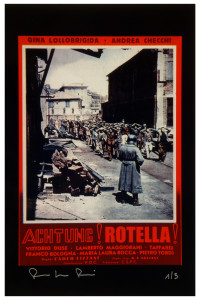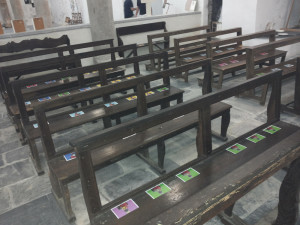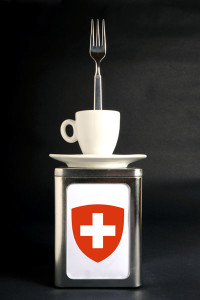Lorenzo Mortara (2009) – Elvis
This new exhibition of the artist Parisi, which includes performances and photographs with a provocative title which has several meanings “I have seen Elvis again”, does not only wish to represent an interesting and incisive event able to capture the audience’s attention and interest, but most of all, to be a wilful act of waking up our sense of criticism (or sixth sense?), reconnecting our best vital energies to present day reality. Art should not be a marginal experience in our society, nor an end in itself, and not only experienced as a pure and detached exercise of imagination. In our contemporary society the challenges are countless for the freedom of our thoughts and for carrying out our most profound and natural desires. Canvas-cradles and Teddy bear–Totems, or a receptacle of undifferentiated gloves are common objects used here in a new evocative and strongly imaginative role, the conception of which, goes in the direction of Conceptual Art. In addition to the theme of Teddy bears and gloves used by the artist in previous performances (Flash Art Show, Milan, Italy 2005; Barcelona, Spain 2006, DOPPIASCLERO, Genoa, Italy 2008), in this new performance we are close to new concepts near to the Italian artist’s heart: for example the Madonna of Lourdes advertised by Coca-Cola, a soccer match ticket for a match between Yugoslavia and Italy in 1955, a dog food advertisement. Cradles – a symbol of our infancy – remind us of our origins and of the extreme fragility of our first years of life, a delicate and fundamental period in the maturity of our existence and oneself. In truth this phase is extended to the entire phase of adolescence. In the same manner, Teddy bears well represent this idyllic and purely sentimental phase. Here Parisi exhibits gloves, gloves, gloves, an array of latex gloves. The product of contemporary man: the intrusion, the contradiction, the reversal of values. The symbol of gloves means tears, laceration, pain, death, supremacy of the wars, abuse of power on an inert human body, illness or death. The poetics of this ironic, disenchanting and spiritual artist – symbolizing impossible scenes as well as a play upon words and meanings – wishes to strike and to seize attention, in order to astonish and in this way to deepen our knowledge of distorted messages, of conditionings, of false myths which we come across incessantly every day. The message of – I HAVE SEEN ELVIS AGAIN – is apocalyptic, synaptic, emphatic, declaratory, or rather a warning and at the same time a rebellion against the human nature and against the weak nature of his mind. Nevertheless, the artistic expression must maintain its originality and its independence in spite of its of Art engagé characteristics. As sharply observed by the famous and studious art critic, Edgar Wind (1900-1971), in his lecture titled “Participation aesthetics”: from this twofold root – participation and fiction – art draws its power either by extending our vision, transferring us beyond immediate reality or by deepening our experience through our participation. In the works of art of Parisi there is much fantasy, much irony, much imagination and sometimes the untold, the not shown or the only hinted desire that wishes to play a major role in the real work just to stimulate more and more our participation and to render rapid, almost like lightning, our experience – Next shower’d into my fantasy a shape – Dante, Purgatory XVII, 25. The artist goads us into keeping our awareness alert and indicates a path to us through photos and performances which help us to go beyond, to overstep the common sense of things and the messages that surround us. The danger today is in the continuous and insidious auditory and visual stress, disinformation, deviated propaganda, historical revisionism, in trashy television programmes and advertising spots. Is there anything else other than State’s religion?, fanaticism?, wars?, imperialism?, and consumerism? Yes, there is mankind, its spirituality and its intimacy with its truth and conquests.
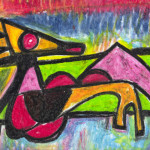 Previous Post
Previous Post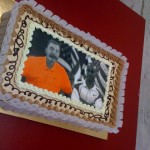 Next Post
Next Post